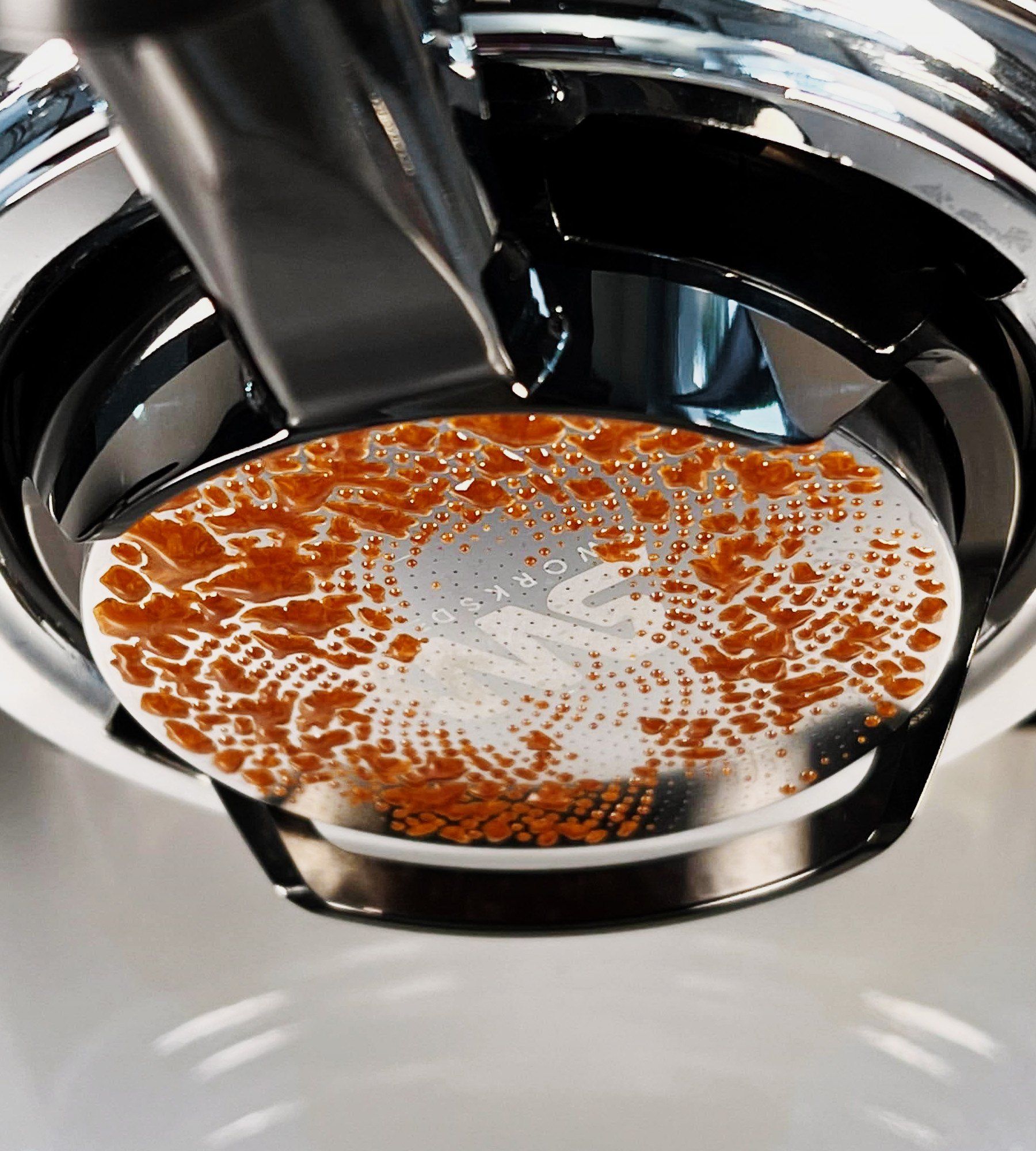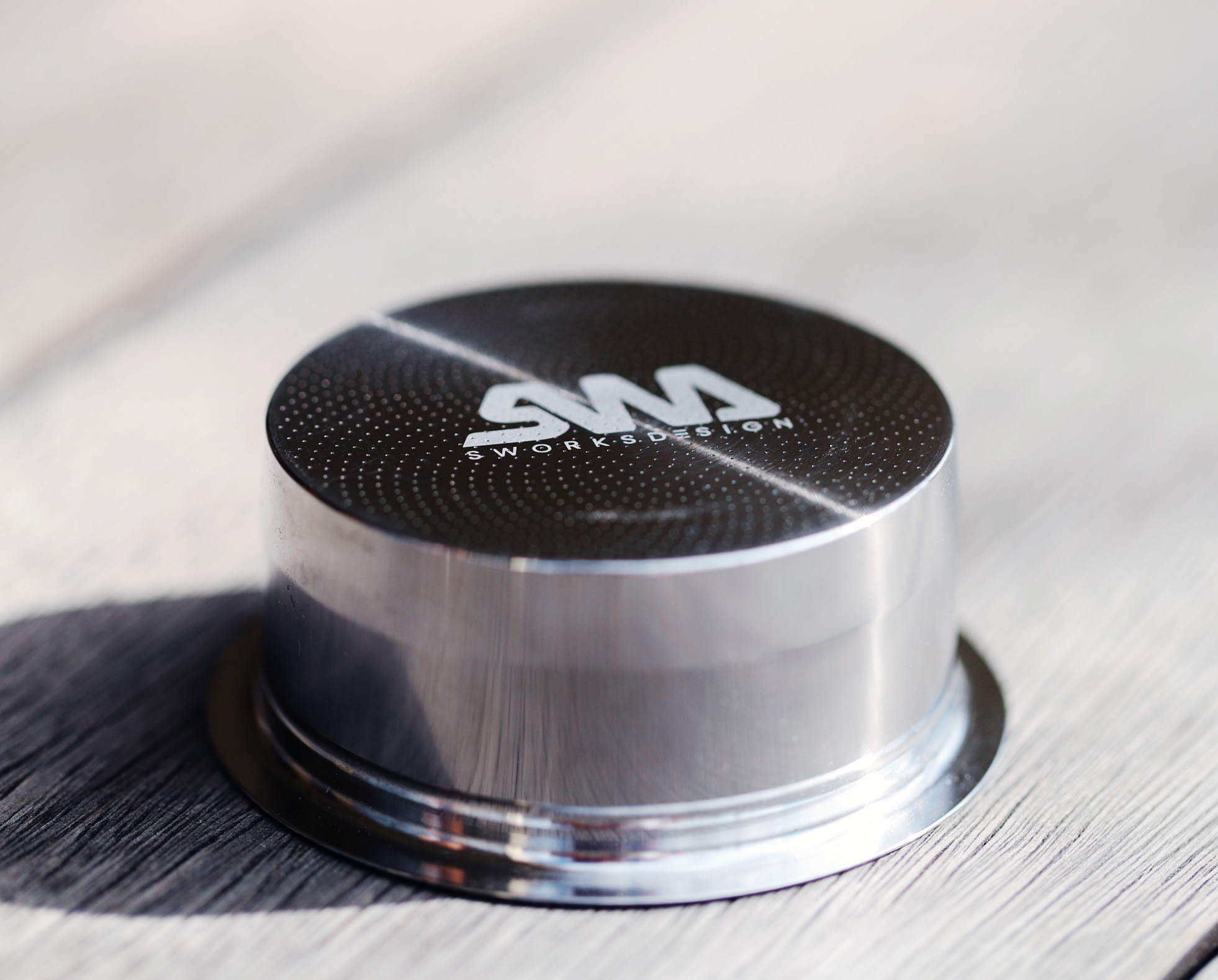While the machines you see in cafes operate in much the same way as they have done for years, a quiet revolution is taking place behind the scenes. This revolution is not being led by the makers of espresso machines. The big leap in espresso technology is something brilliantly simple, intuitive and affordable. Can you guess what’s behind it all? It’s the ‘high extraction’ filter basket.
After spending a few weeks testing out some of the new players in the ‘fancy filter basket’ space, we have seen some huge improvements in the taste, extraction yield, and efficiency of our shot making. At a time where the cost of running a cafe is at an all time high, there is suddenly a big opportunity for cafes to save time and money. For anyone who is considering a machine upgrade, hold that thought for a second because you could very well achieve the level-up in quality you desire for less than a couple of hundred bucks.
More than a decade ago, Vince Fedele set the gold standard for modern filter baskets with the launch of VST baskets. These were revolutionary at the time, and were rapidly adopted in specialty coffee. In the following years, this technology didn’t see any significant changes. But in just the past year or two, a slew of challengers have suddenly appeared, promising more holes, faster flow, and higher and more even extractions.
Armed with this crop of new baskets, better distribution tools — and an open mind about the shot time and brew ratio needed to make great espresso — baristas are making different styles of coffee, and pushing the envelope of extraction further than ever before.
New Kids on the Diffusion Block
The new designs, by manufacturers such as Weber Workshops, Sworksdesign, and Wafo, operate on broadly similar principles. They are designed to have straighter sides, and for the basket holes to go as close as possible to the edge of the puck, allowing more even extraction of the coffee around the edge of the basket. They are made to tighter tolerances, and designed to warp less under the high pressures found in espresso machines. But the biggest difference, compared with previous filter baskets, is that they allow much faster flow, thereby allowing baristas to grind finer and extract higher than ever before.
 The Sworksdesign Billet basket allows fast flow in an espresso, despite the tiny size of the exit holes.
The Sworksdesign Billet basket allows fast flow in an espresso, despite the tiny size of the exit holes.
Sheldon Wong, the founder of Sworksdesign, explains that the starting point for his basket design was to push for the holes at the bottom to cover the widest possible area, so that the entire puck can be extracted equally effectively. “The holes span a 57.5mm diameter area on my 58mm basket,” he says.
In older basket designs, on the other hand, the holes don’t extend all the way to the edge. “In regions without holes, water will flow to the bottom, hit a wall and then travel horizontally to find the nearest exit,” Sheldon says. “The flow velocity here will be slower than the water paths that happen to line up with a hole in the basket. Water will always prefer flowing through paths of less or least resistance — leading to locally higher extraction and leaving other areas under-extracted.”
 The Sworksdesign Billet basket has straight sides and holes positioned close to the edge of the basket, to maximise extraction at the edge of the puck.
The Sworksdesign Billet basket has straight sides and holes positioned close to the edge of the basket, to maximise extraction at the edge of the puck.
The Sworksdesign basket is machined from a solid piece of heat-treated 17-4 stainless steel — a particularly strong form of steel, usually found in turbine blades and rocket engines. Compared to standard baskets, which are stamped out of a thin sheet of lower-grade steel, these are better able to withstand the forces involved in espresso making. “[Coffee] particles push on the basket floor with nearly 250 kgs of force (or more when above 9 bars) — it’s no wonder other baskets deform permanently, even when made thick and heavy,” Sheldon says.
High Speed, High Extraction
The new breed of basket designs claim to increase extraction, and there’s plenty of evidence (for example from Lance Hedrick and Robert McKeon Aloe) out there that they can do that under the right conditions.
We ran a quick test of our own, trying out the standard Sworksdesign Billet basket against a classic older basket from IMS, and had very similar results: the Billet required a finer grind size to reach the same shot time, and achieved considerably higher extractions — by nearly three percentage points. Our focus was on taking objective measurements, but as it happens, the shots from the Billet also tasted great.
| Dose (g) | Yield (g) | Shot time (s) | Grind Setting (µm) | TDS% | EY% | |
| Sworks Billet | 16.2 | 44.3 | 18.3 | 140 | 7.9 | 21.9 |
| IMS | 16.2 | 43.2 | 19.0 | 172 | 7.0 | 19.1 |
The Sworks Billet enabled much higher extractions than the IMS filter. The difference was highly significant (T-test, p=0.016)
For these tests we used a Mazzer ZM grinder, a Dalla Corte Mina, and the 3065 Espresso Blend from Code Black. We also used a fast-extracting recipe (aka turbo shot), which may well be where this type of basket particularly excels. In fact, even at the finest setting possible — on a pair of burrs capable of grinding extremely fine — we still found the Sworks basket delivered fast shot times, and this high flow rate may well be the key to the high extractions that this type of basket allows. We also tried out the HE% baskets from Pesado compared to classic Pullman baskets, with similar results: while the Pullman baskets performed very well, the Pesado baskets allowed faster flow, averaging 6% higher extraction than the Pullman baskets in the tests we conducted.
But why do the new style of baskets allow faster flow? It’s not as simple as saying the basket has more holes, and therefore allows faster flow. The Sworks baskets have lots of holes, but the individual holes are very small — to the point that there may even be less open area at the bottom of the basket overall than in the IMS baskets.
Hole patterns in modern baskets. From top left: IMS, Pullman, Sworksdesign, Pesado HE%
Even if the total open area is similar, smaller holes create much more resistance. Regular readers may remember Poiseuille’s Law, which says that (assuming laminar flow), if you halve the radius of a pore, the resistance to flow increases by a whopping 16 times.
The length of the channel also matters: longer channels (i.e. holes in thicker baskets) create more resistance than shorter ones. In fact, Sheldon purposely kept the thickness of the Billet basket base lower than many other modern baskets, to reduce the amount of clogging. But many baskets feature conical holes, to reduce the effective length of the channel, making a comparison difficult.
 Conical holes reduce the effective channel length of a basket. Where the hole starts to widen, it no longer adds significantly to the total resistance of the channel.
Conical holes reduce the effective channel length of a basket. Where the hole starts to widen, it no longer adds significantly to the total resistance of the channel.
Unexpected Resistance
Calculating the effects of all the different variables that can affect the resistance of a basket is not straightforward, but the small holes and long channels of the Billet should mean that it puts up a lot of resistance to flow, when in fact the opposite is the case.
Why would this be? We can only assume that when brewing an espresso, the design of the holes somehow reduces clogging and blockage by fines — but then, plenty of users have reported that very small holes in the filter basket become easily blocked by small coffee particles, making this style of basket much harder to clean.
 A coffee particle stuck in one of the holes at the bottom of an Sworks basket, as seen through a microscope in Lance Hedrick’s video review of modern baskets.
A coffee particle stuck in one of the holes at the bottom of an Sworks basket, as seen through a microscope in Lance Hedrick’s video review of modern baskets.
To resolve this contradiction, we will need more information. Firstly, we want to try testing these baskets using coffee with the fines completely removed, in order to understand the role that fines play. Much easier said than done, since static cling means that sieving can’t dislodge the smallest particles, but we have some potential ideas to make this possible that we hope to explore in a future post.
More importantly, we need a better way to analyse the basket holes themselves. To this end, Professor Abbott is working on an app to calculate the size of filter basket holes from a photo, inspired by this insightful post by Robert McKeon Aloe. Understanding why these baskets perform so well could be the first step towards optimising their design even further. Until then, you’ll find us enjoying faster shots than ever, thanks to the new breed of fast-flow baskets.
Revolutionizing the Espresso Game: The Rise of High Extraction Filter Baskets
Hey there, coffee lovers! You know those shiny espresso machines you see in your favorite cafes? They might look the same as they always have, but there’s a quiet revolution brewing behind the scenes. No, it’s not about the espresso machines themselves. It’s something far simpler, yet incredibly effective. Can you guess what it is? It’s all about the ‘high extraction’ filter basket.
A Game-Changer in Your Cup
We’ve been playing around with some of these new ‘fancy filter baskets’ for a few weeks now and let me tell you – we’re impressed! The taste, extraction yield, and efficiency of our shot making have improved dramatically. And here’s a fun fact: at a time when running a cafe is costlier than ever, these little game-changers offer an opportunity to save both time and money. So if you’re thinking about upgrading your machine to improve your coffee quality, hold that thought! You might just achieve that level-up for less than two hundred bucks.
The Gold Standard of Filter Baskets
Let’s rewind back over a decade ago when Vince Fedele set the gold standard for modern filter baskets with his VST baskets. These were revolutionary at their time and quickly became popular in specialty coffee circles. But after years without any significant changes in this technology, we’ve seen an influx of new players promising more holes, faster flow rates and higher extractions.
New Kids on the Diffusion Block
These new designs by manufacturers like Weber Workshops, Sworksdesign, and Wafo operate on broadly similar principles. They feature straighter sides and basket holes that go as close as possible to the edge of the puck. This allows for a more even extraction of the coffee around the edge of the basket. They’re made to tighter tolerances, designed to warp less under high pressures, and most importantly, they allow much faster flow. This means baristas can grind finer and extract higher than ever before.
Pushing the Boundaries of Extraction
Sheldon Wong, founder of Sworksdesign, explains that his basket design aims to cover the widest possible area with holes at the bottom. This ensures that every bit of your coffee puck gets extracted equally effectively. In older designs, water would hit a wall in regions without holes and then travel horizontally to find an exit. But with these new designs, water flows through paths of least resistance leading to higher extraction.
High Speed, High Extraction
The new breed of baskets claim to increase extraction and there’s plenty of evidence out there supporting this claim. We ran our own test comparing a standard Sworksdesign Billet basket against an older IMS basket and found similar results: The Billet required a finer grind size for the same shot time but achieved considerably higher extractions.
The Science Behind Faster Flow
You might be wondering why these new style baskets allow faster flow? It’s not as simple as saying they have more holes hence faster flow. The Sworks baskets do have lots of holes but they are very small which should technically create more resistance according to Poiseuille’s Law.
A Mystery Yet To Be Unraveled
We’re still trying to figure out why despite having small holes and long channels which should create high resistance to flow, these baskets actually offer faster flow rates. Our assumption is that during brewing, the design somehow reduces clogging by fines but we need more information to confirm this.
Looking Forward
While we continue to explore and understand these new baskets, we’re definitely enjoying faster shots than ever thanks to this new breed of fast-flow baskets. So next time you sip on your espresso, remember there’s a lot more science and innovation behind that delicious cup than meets the eye!







You must be logged in to post a comment.